Ziyi Ni
GitTaskBench: A Benchmark for Code Agents Solving Real-World Tasks Through Code Repository Leveraging
Aug 26, 2025Abstract:Beyond scratch coding, exploiting large-scale code repositories (e.g., GitHub) for practical tasks is vital in real-world software development, yet current benchmarks rarely evaluate code agents in such authentic, workflow-driven scenarios. To bridge this gap, we introduce GitTaskBench, a benchmark designed to systematically assess this capability via 54 realistic tasks across 7 modalities and 7 domains. Each task pairs a relevant repository with an automated, human-curated evaluation harness specifying practical success criteria. Beyond measuring execution and task success, we also propose the alpha-value metric to quantify the economic benefit of agent performance, which integrates task success rates, token cost, and average developer salaries. Experiments across three state-of-the-art agent frameworks with multiple advanced LLMs show that leveraging code repositories for complex task solving remains challenging: even the best-performing system, OpenHands+Claude 3.7, solves only 48.15% of tasks. Error analysis attributes over half of failures to seemingly mundane yet critical steps like environment setup and dependency resolution, highlighting the need for more robust workflow management and increased timeout preparedness. By releasing GitTaskBench, we aim to drive progress and attention toward repository-aware code reasoning, execution, and deployment -- moving agents closer to solving complex, end-to-end real-world tasks. The benchmark and code are open-sourced at https://github.com/QuantaAlpha/GitTaskBench.
RepoMaster: Autonomous Exploration and Understanding of GitHub Repositories for Complex Task Solving
May 27, 2025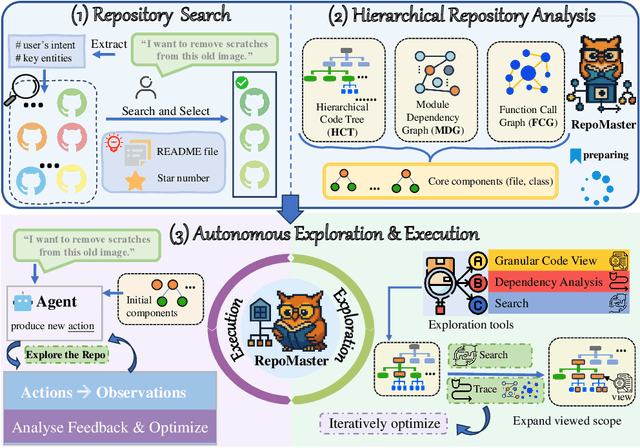

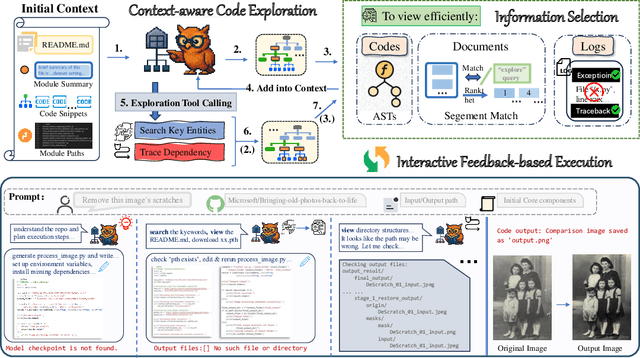

Abstract:The ultimate goal of code agents is to solve complex tasks autonomously. Although large language models (LLMs) have made substantial progress in code generation, real-world tasks typically demand full-fledged code repositories rather than simple scripts. Building such repositories from scratch remains a major challenge. Fortunately, GitHub hosts a vast, evolving collection of open-source repositories, which developers frequently reuse as modular components for complex tasks. Yet, existing frameworks like OpenHands and SWE-Agent still struggle to effectively leverage these valuable resources. Relying solely on README files provides insufficient guidance, and deeper exploration reveals two core obstacles: overwhelming information and tangled dependencies of repositories, both constrained by the limited context windows of current LLMs. To tackle these issues, we propose RepoMaster, an autonomous agent framework designed to explore and reuse GitHub repositories for solving complex tasks. For efficient understanding, RepoMaster constructs function-call graphs, module-dependency graphs, and hierarchical code trees to identify essential components, providing only identified core elements to the LLMs rather than the entire repository. During autonomous execution, it progressively explores related components using our exploration tools and prunes information to optimize context usage. Evaluated on the adjusted MLE-bench, RepoMaster achieves a 110% relative boost in valid submissions over the strongest baseline OpenHands. On our newly released GitTaskBench, RepoMaster lifts the task-pass rate from 24.1% to 62.9% while reducing token usage by 95%. Our code and demonstration materials are publicly available at https://github.com/wanghuacan/RepoMaster.
Tree-of-Code: A Tree-Structured Exploring Framework for End-to-End Code Generation and Execution in Complex Task Handling
Dec 19, 2024Abstract:Solving complex reasoning tasks is a key real-world application of agents. Thanks to the pretraining of Large Language Models (LLMs) on code data, recent approaches like CodeAct successfully use code as LLM agents' action, achieving good results. However, CodeAct greedily generates the next action's code block by relying on fragmented thoughts, resulting in inconsistency and instability. Moreover, CodeAct lacks action-related ground-truth (GT), making its supervision signals and termination conditions questionable in multi-turn interactions. To address these issues, we first introduce a simple yet effective end-to-end code generation paradigm, CodeProgram, which leverages code's systematic logic to align with global reasoning and enable cohesive problem-solving. Then, we propose Tree-of-Code (ToC), which self-grows CodeProgram nodes based on the executable nature of the code and enables self-supervision in a GT-free scenario. Experimental results on two datasets using ten popular zero-shot LLMs show ToC remarkably boosts accuracy by nearly 20% over CodeAct with less than 1/4 turns. Several LLMs even perform better on one-turn CodeProgram than on multi-turn CodeAct. To further investigate the trade-off between efficacy and efficiency, we test different ToC tree sizes and exploration mechanisms. We also highlight the potential of ToC's end-to-end data generation for supervised and reinforced fine-tuning.
Tree-of-Code: A Hybrid Approach for Robust Complex Task Planning and Execution
Dec 18, 2024Abstract:The exceptional capabilities of large language models (LLMs) have substantially accelerated the rapid rise and widespread adoption of agents. Recent studies have demonstrated that generating Python code to consolidate LLM-based agents' actions into a unified action space (CodeAct) is a promising approach for developing real-world LLM agents. However, this step-by-step code generation approach often lacks consistency and robustness, leading to instability in agent applications, particularly for complex reasoning and out-of-domain tasks. In this paper, we propose a novel approach called Tree-of-Code (ToC) to tackle the challenges of complex problem planning and execution with an end-to-end mechanism. By integrating key ideas from both Tree-of-Thought and CodeAct, ToC combines their strengths to enhance solution exploration. In our framework, each final code execution result is treated as a node in the decision tree, with a breadth-first search strategy employed to explore potential solutions. The final outcome is determined through a voting mechanism based on the outputs of the nodes.
SpikeLM: Towards General Spike-Driven Language Modeling via Elastic Bi-Spiking Mechanisms
Jun 05, 2024
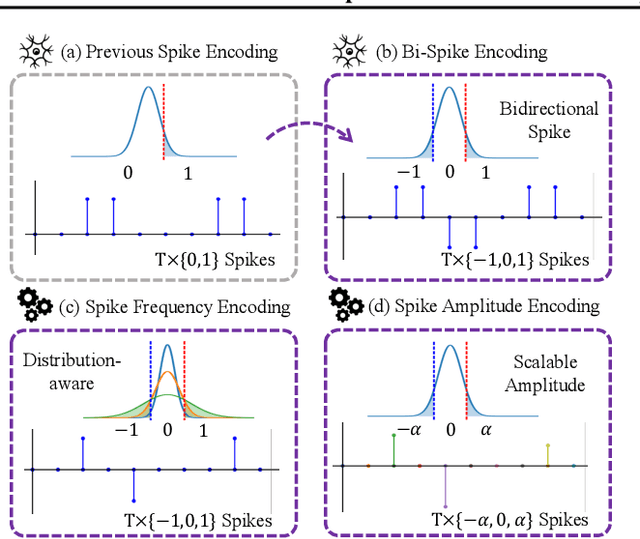
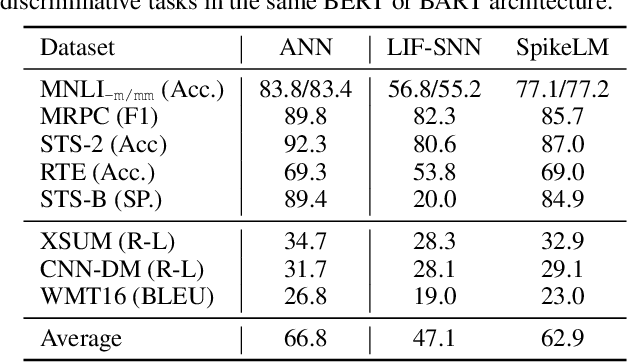
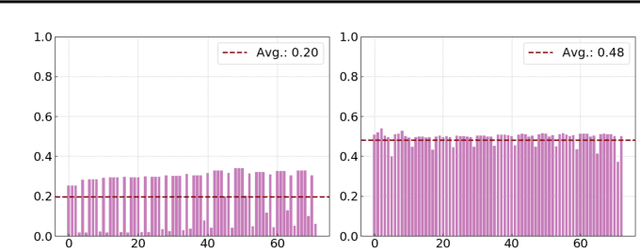
Abstract:Towards energy-efficient artificial intelligence similar to the human brain, the bio-inspired spiking neural networks (SNNs) have advantages of biological plausibility, event-driven sparsity, and binary activation. Recently, large-scale language models exhibit promising generalization capability, making it a valuable issue to explore more general spike-driven models. However, the binary spikes in existing SNNs fail to encode adequate semantic information, placing technological challenges for generalization. This work proposes the first fully spiking mechanism for general language tasks, including both discriminative and generative ones. Different from previous spikes with {0,1} levels, we propose a more general spike formulation with bi-directional, elastic amplitude, and elastic frequency encoding, while still maintaining the addition nature of SNNs. In a single time step, the spike is enhanced by direction and amplitude information; in spike frequency, a strategy to control spike firing rate is well designed. We plug this elastic bi-spiking mechanism in language modeling, named SpikeLM. It is the first time to handle general language tasks with fully spike-driven models, which achieve much higher accuracy than previously possible. SpikeLM also greatly bridges the performance gap between SNNs and ANNs in language modeling. Our code is available at https://github.com/Xingrun-Xing/SpikeLM.
A Knowledge-enhanced Two-stage Generative Framework for Medical Dialogue Information Extraction
Jul 30, 2023Abstract:This paper focuses on term-status pair extraction from medical dialogues (MD-TSPE), which is essential in diagnosis dialogue systems and the automatic scribe of electronic medical records (EMRs). In the past few years, works on MD-TSPE have attracted increasing research attention, especially after the remarkable progress made by generative methods. However, these generative methods output a whole sequence consisting of term-status pairs in one stage and ignore integrating prior knowledge, which demands a deeper understanding to model the relationship between terms and infer the status of each term. This paper presents a knowledge-enhanced two-stage generative framework (KTGF) to address the above challenges. Using task-specific prompts, we employ a single model to complete the MD-TSPE through two phases in a unified generative form: we generate all terms the first and then generate the status of each generated term. In this way, the relationship between terms can be learned more effectively from the sequence containing only terms in the first phase, and our designed knowledge-enhanced prompt in the second phase can leverage the category and status candidates of the generated term for status generation. Furthermore, our proposed special status ``not mentioned" makes more terms available and enriches the training data in the second phase, which is critical in the low-resource setting. The experiments on the Chunyu and CMDD datasets show that the proposed method achieves superior results compared to the state-of-the-art models in the full training and low-resource settings.
ViLaS: Integrating Vision and Language into Automatic Speech Recognition
May 31, 2023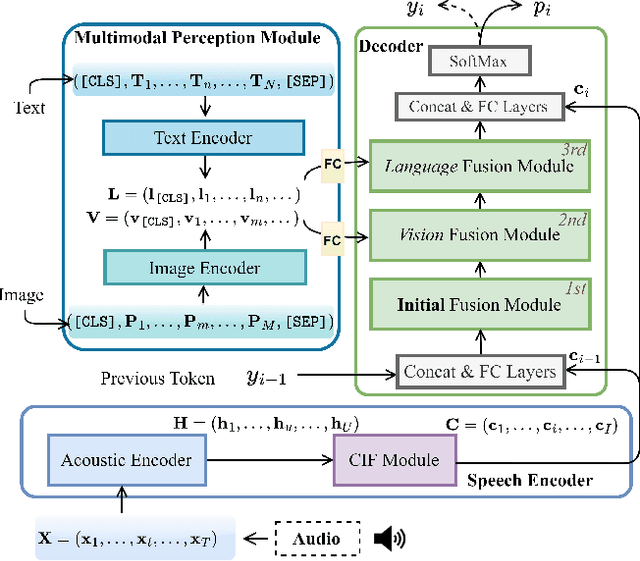

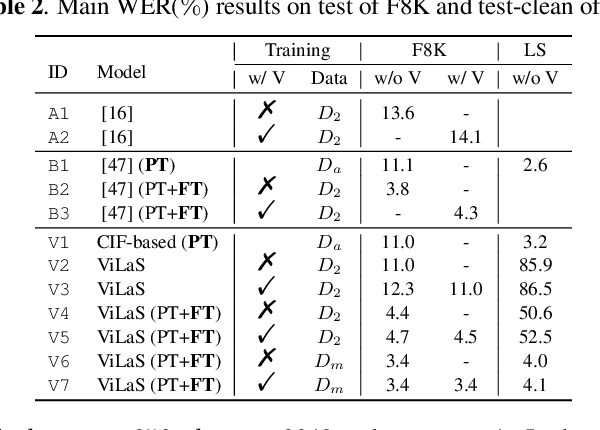
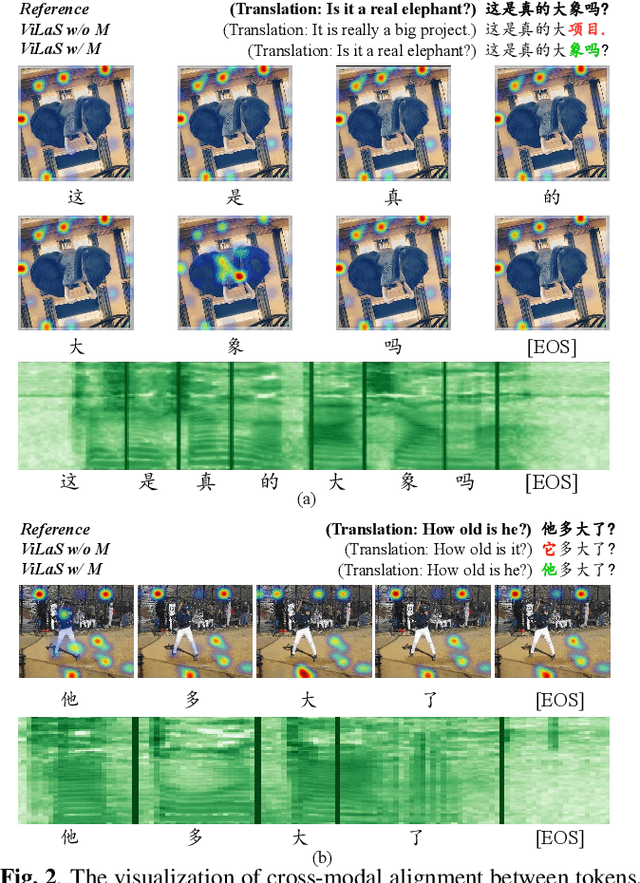
Abstract:Employing additional multimodal information to improve automatic speech recognition (ASR) performance has been proven effective in previous works. However, many of these works focus only on the utilization of visual cues from human lip motion. In fact, context-dependent visual and linguistic cues can also be used to improve ASR performance in many scenarios. In this paper, we first propose a multimodal ASR model (ViLaS) that can simultaneously or separately integrate visual and linguistic cues to help recognize the input speech, and introduce a training strategy that can improve performance in modal-incomplete test scenarios. Then, we create a multimodal ASR dataset (VSDial) with visual and linguistic cues to explore the effects of integrating vision and language. Finally, we report empirical results on the public Flickr8K and self-constructed VSDial datasets, investigate cross-modal fusion schemes, and analyze fine-grained cross-modal alignment on VSDial.
Mixture of personality improved Spiking actor network for efficient multi-agent cooperation
May 10, 2023



Abstract:Adaptive human-agent and agent-agent cooperation are becoming more and more critical in the research area of multi-agent reinforcement learning (MARL), where remarked progress has been made with the help of deep neural networks. However, many established algorithms can only perform well during the learning paradigm but exhibit poor generalization during cooperation with other unseen partners. The personality theory in cognitive psychology describes that humans can well handle the above cooperation challenge by predicting others' personalities first and then their complex actions. Inspired by this two-step psychology theory, we propose a biologically plausible mixture of personality (MoP) improved spiking actor network (SAN), whereby a determinantal point process is used to simulate the complex formation and integration of different types of personality in MoP, and dynamic and spiking neurons are incorporated into the SAN for the efficient reinforcement learning. The benchmark Overcooked task, containing a strong requirement for cooperative cooking, is selected to test the proposed MoP-SAN. The experimental results show that the MoP-SAN can achieve both high performances during not only the learning paradigm but also the generalization test (i.e., cooperation with other unseen agents) paradigm where most counterpart deep actor networks failed. Necessary ablation experiments and visualization analyses were conducted to explain why MoP and SAN are effective in multi-agent reinforcement learning scenarios while DNN performs poorly in the generalization test.
Matching-based Term Semantics Pre-training for Spoken Patient Query Understanding
Mar 02, 2023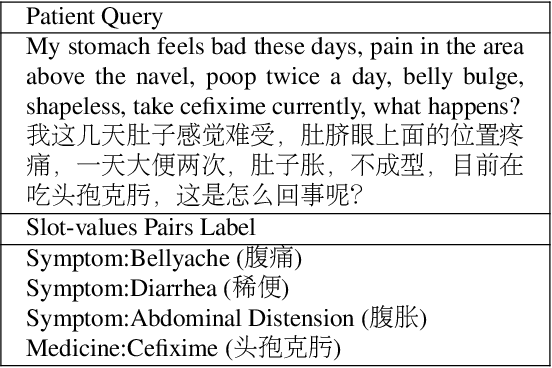
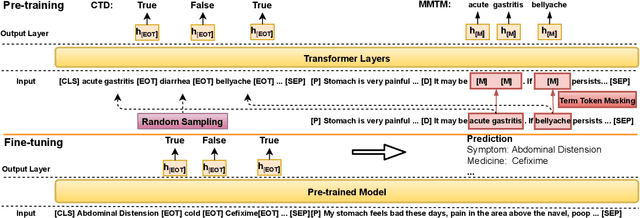


Abstract:Medical Slot Filling (MSF) task aims to convert medical queries into structured information, playing an essential role in diagnosis dialogue systems. However, the lack of sufficient term semantics learning makes existing approaches hard to capture semantically identical but colloquial expressions of terms in medical conversations. In this work, we formalize MSF into a matching problem and propose a Term Semantics Pre-trained Matching Network (TSPMN) that takes both terms and queries as input to model their semantic interaction. To learn term semantics better, we further design two self-supervised objectives, including Contrastive Term Discrimination (CTD) and Matching-based Mask Term Modeling (MMTM). CTD determines whether it is the masked term in the dialogue for each given term, while MMTM directly predicts the masked ones. Experimental results on two Chinese benchmarks show that TSPMN outperforms strong baselines, especially in few-shot settings.
 Add to Chrome
Add to Chrome Add to Firefox
Add to Firefox Add to Edge
Add to Edge